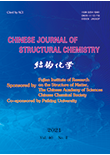Synthesis, Structure and Highly Enhanced Phosphorescence of a Cadmium(II) Coordination Polymer Assembled with 1,4-Naphthalenedicarboxylic Acid and 2-Propylimidazole
CHANG Xin-Hong*, YANG Xiao-Gang, ZHAI Zhi-Min, CHEN Jia-Yi and LI Fei-Fei
Chin. J. Struct. Chem. 2021, 40, 187-192 DOI: 10.14102/j.cnki.0254-5861.2011-2793
February 15, 2021
coordination polymer, crystal structure, room temperature phosphorescence, theory calculations
ABSTRACT
One cadmium(II)
coordination polymer [Cd(1,4-NDC)(PPIM)2]n (1, 1,4-H2NDC
= 1,4-na- phthalenedicarboxylic acid, PPIM = 2-propylimidazole), has been
synthesized under hydrothermal conditions and structurally characterized by
elemental analysis, TGA and X-ray single-crystal diffraction. Complex 1
crystallizes in monoclinic with space group P21/n, a = 8.8292(2), b = 16.6936(4), c = 16.7869(4)
Å, β = 99.701(2)°, V = 2438.86(10) Å3, Z = 4, Dc = 1.489 Mg/m3, F(000) = 1112, μ = 0.932 mm–1, S = 1.076, the final R = 0.0360 and wR = 0.0850. In 1, the 1,4-NDC ligand
bridges the Cd(II) to form a 1D infinite chain, which are connected through N–H···O
hydrogen bond to form a 2D layer then to an overall 3D supramolecular
structure. The time-resolved measurements indicate that 1 shows highly prolonged
phosphorescent lifetime about 452 times in comparison with that of pristine PPIM
ligand. Single-crystal analysis and theory
calculations indicate that strong coordination bonds and complete separation of
HOMOs and LUMOs in the rigid matrix of 1 promote the long-last phosphorescence
emission.








